|
Aurora Gallery back to spaceweather.com |
| Summary: A coronal mass ejection hurled into space by sunspot 652 (movie) hit Earth's magnetic field on July 26th at approximately 2300 UT. The impact triggered a severe geomagnetic storm that lasted for 12+ hours, sparking auroras as far south as California in the United States. See also the May-June 2004 aurora gallery. Page 1 | Page 2 | Page 3 | Page 4 | Page 5 | This is Page 6 | Page 7 Got
pictures? Submit
them. |
| Photographer, Location | Images | Comments | |
|
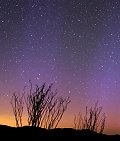
|
Dennis
Mammana, Anza-Borrego Desert State Park in Borrego Springs, CA, USA Jul. 27 |
#1, #2, more | From this far-southern location, these rays were easily visible and extended up about 40 degrees from the horizon, though they appeared colorless to the eye. Both shots were taken just before dawn with a Canon 10D and 24mm f/1.4Llens (ISO 800, f/1.6, 30sec) |
|

|
David Lee,
Victoria BC Jul. 26 |
#1 |
Alerted by a phone call we rushed out to Island View Beach to see if we could spot yet another night of aurora. When we arrived we could see a shimmering green glow but sadly it subsided. Minutes later just before midnight we noticed a what appeared to be a contrail in the East which twirled into a V shape. In time a ribbon of light spanned the East and West horizons. The view is overhead at the zenith with the aurora passing through the Summer Triangle. Photo details: Fuji S2, ISO 800, 16mmAF Nikkor, f/2.8 for 30 seconds. |
|
|
Philippe
Moussette, Cap-Rouge Québec Canada Jul. 26 |
#1, #2, #3, #4, more | Photo details: Digital rebel camera at 1600 ASA, 5 to 10 second exposures. |
|
|
Wade
B Clark Jr, Baker Lake, Washington State, USA Jul. 26 |
#1, #2, #3, more | Although the K-indices indicated there should be a wonderful show going on, we observed only a "Hydrogen arc" (pictured here) just south of the zenith that drifted southward and disappeared. Also a few dim colorless rays that reached aprox. 70 degrees in elevation. Viewing may have been hampered by moonlight and smoke from the Swift Creek forest fire. |
|
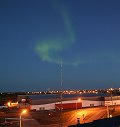
|
Peter
Jeffery, Yellowknife, NT, Canada Jul. 27 |
#1, #2, #3 | It was a great display of auroras for us in July. There isn't very much darkness at this time of the year up here. Photos taken on a canon 10d with a 17-35mm lens on f2.8 @ 100 iso for about 2-6 seconds. |
|
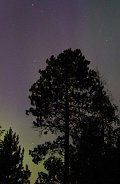
|
Jesse
Phillips, Angora & Britt, Minnesota, USA Jul. 27 |
#1, #2, #3, #4, | The auroras were very active just after sunset. They faded and picked up again later as I drove around trying to find good spots for photos. They became very active again in the early morning after the moon started to drop back towards the horizon and provided all sorts of colors, streaks, swirls, and dancing vibrations. Photo details: Sony Cybershot DSC-F717, ISO 100, f2.0, 15-20 seconds |
|
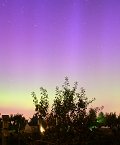
|
Greg Owen,
Rochester, Washington USA Jul. 27 |
#1, #2, #3, #4 |
The display came and went all night. The coloring seems to have varied from a couple nights ago. Photo details: Canon Digital Rebel, ISO 400, 30-40 seconds. |
|
|
Tom
Gwilym, Renton, WA USA Jul. 27 |
#1, #2 | I wasn't thinking much about the auroras since I was fiddling with my telescope in my observatory. I finally looked up and saw a bright streak across the sky from the NE across to the NW. I ran in and grabbed my digital camera. These photos are taken with a 3.2 megapixel camera at ISO 400, and 16 second exposures (tilted since that was most stable way I could support it at the time!). |
|

|
Carlton McMillan,
Lakeville, just south of Minneapolis, MN. Jul. 26 |
#1, #2, #3, #4 |
All images were shot with a Nikon D100 1600ISO - 30sec @ 2.8 Lens used was a 20 mm Nikkor |
|
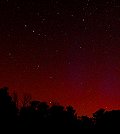
|
Vic
& Jen Winter, the Charles Douglas Observatory, ICSTARS Ranch north of Warrensburg, Missouri, USA Jul. 28 |
#1, more | High solar activity and a huge sunspot complex sparked a couple of nights of aurora that reached as far south as Missouri. A faint red glow was spotted about 2 a.m. on the morning of July 28, 2004 at the Charles Douglas Observatory located north of Warrensburg, Missouri. A couple of patches of purple aurora appeared on the digital images. Photographed with a Nikon D-100, 16mm lens, 60 sec. exposure at f2.8 (c)2004 Vic & Jen Winter/ICSTARS Astronomy. |
|
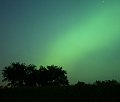
|
John
Carlson, Hutchinson, Minnesota Jul. 27 |
#1, #2, more | About 05:30 UTC we noticed a broad strong bow. It broke up into rays which continued for 20 minutes. |
more images:
from Eric and David Jorgensen
of Everett, WA; from Steve Abarta
of Yakima, Washington, USA

